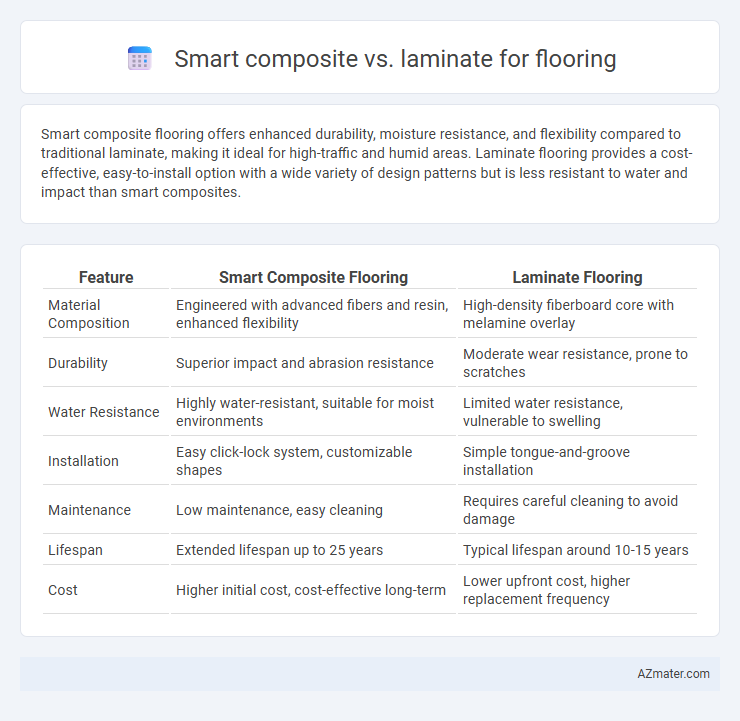Smart composite flooring offers enhanced durability, moisture resistance, and flexibility compared to traditional laminate, making it ideal for high-traffic and humid areas. Laminate flooring provides a cost-effective, easy-to-install option with a wide variety of design patterns but is less resistant to water and impact than smart composites.
Table of Comparison
| Feature | Smart Composite Flooring | Laminate Flooring |
|---|---|---|
| Material Composition | Engineered with advanced fibers and resin, enhanced flexibility | High-density fiberboard core with melamine overlay |
| Durability | Superior impact and abrasion resistance | Moderate wear resistance, prone to scratches |
| Water Resistance | Highly water-resistant, suitable for moist environments | Limited water resistance, vulnerable to swelling |
| Installation | Easy click-lock system, customizable shapes | Simple tongue-and-groove installation |
| Maintenance | Low maintenance, easy cleaning | Requires careful cleaning to avoid damage |
| Lifespan | Extended lifespan up to 25 years | Typical lifespan around 10-15 years |
| Cost | Higher initial cost, cost-effective long-term | Lower upfront cost, higher replacement frequency |
Introduction to Smart Composite and Laminate Flooring
Smart composite flooring combines engineered materials such as high-density fiberboards with durable resins and wear layers to provide enhanced moisture resistance and superior durability compared to traditional options. Laminate flooring consists of layers, including a photographic applique layer under a clear protective surface, over a fiberboard core that offers affordability and easy installation but generally less moisture resistance. Understanding these materials' composition helps in choosing flooring solutions that balance performance, aesthetics, and maintenance requirements for residential or commercial spaces.
Composition and Material Differences
Smart composite flooring utilizes engineered layers combining natural wood fibers, resins, and polymers, providing enhanced durability and moisture resistance. Laminate flooring consists primarily of high-density fiberboard (HDF) core topped with a photographic applique layer and a protective melamine resin wear layer, emphasizing cost-effectiveness and ease of installation. The key material difference lies in smart composites' use of advanced bonding agents and composite substrates versus laminate's more uniform fiberboard and resin overlay construction.
Durability and Lifespan Comparison
Smart composite flooring offers superior durability compared to laminate due to its multi-layered construction and moisture-resistant core, making it less prone to warping and swelling. Laminate flooring, while cost-effective, typically has a shorter lifespan of 10-20 years, whereas smart composite floors can last 25-30 years with proper maintenance. Enhanced scratch resistance and impact absorption further extend the longevity of smart composite flooring, making it a more resilient option for high-traffic areas.
Installation Process and Flexibility
Smart composite flooring offers a quicker and more straightforward installation process compared to laminate, often featuring click-lock systems that require no adhesive, making it ideal for DIY projects. Its flexibility allows it to better accommodate subfloor imperfections and slight movements without cracking, unlike laminate which can be more rigid and prone to snapping under stress. This enhanced adaptability makes smart composite flooring a preferred choice for uneven surfaces and dynamic environments.
Aesthetic Options and Design Variety
Smart composite flooring offers a broader range of aesthetic options and design variety compared to traditional laminate, featuring realistic textures and customizable patterns that mimic natural wood, stone, or tile. Its advanced manufacturing process allows for enhanced color depth and intricate designs, delivering a more authentic and versatile look suitable for modern interior styles. Laminate flooring, while cost-effective and durable, typically provides fewer design choices and less natural visual appeal, often limited to printed overlays without the same textural dimension as smart composites.
Resistance to Moisture and Environmental Factors
Smart composite flooring offers superior resistance to moisture and environmental factors compared to traditional laminate, featuring waterproof cores and enhanced UV protection that prevent warping and discoloration. Laminate floors, while cost-effective, often absorb moisture leading to swelling, delamination, and mold growth in high-humidity environments. Advanced smart composites incorporate synthetic resins and treated fibers, ensuring long-term durability in kitchens, bathrooms, and outdoor applications where moisture exposure is significant.
Maintenance and Cleaning Requirements
Smart composite flooring demands minimal maintenance due to its durable, non-porous surface that resists stains and scratches, making cleaning quick with just a damp mop or mild detergent. Laminate floors require more careful upkeep to avoid moisture damage; frequent sweeping and prompt spill cleanup are essential to prevent warping or swelling. Both flooring types benefit from regular dusting, but smart composite offers superior ease of maintenance and long-term cleanliness.
Eco-Friendliness and Sustainability
Smart composites for flooring incorporate recycled materials and advanced polymers, reducing reliance on virgin resources and minimizing environmental impact. Laminate flooring often uses wood fibers bonded with resins, which can include formaldehyde-based adhesives, raising concerns over indoor air quality and sustainability. Choosing smart composite flooring supports eco-friendliness through lower carbon footprints and enhanced durability, contributing to longer-lasting, sustainable flooring solutions.
Cost Analysis and Value for Money
Smart composite flooring offers a cost-effective alternative to traditional laminate by combining durability with lower maintenance expenses, resulting in better long-term value for money. Laminate flooring typically incurs higher replacement and repair costs due to less resistance to moisture and wear, impacting overall budget efficiency. Consumers seeking a balance between upfront investment and extended performance find smart composite flooring provides superior cost savings and enhanced durability benefits.
Choosing the Right Flooring: Smart Composite vs Laminate
Smart composite flooring offers enhanced durability and moisture resistance compared to traditional laminate, making it ideal for high-traffic and humid areas. Laminate flooring provides a cost-effective solution with a wide variety of aesthetic options but may lack the long-term resilience of smart composites. Selecting the right flooring depends on factors such as area usage, budget constraints, and desired lifespan.

Infographic: Smart composite vs Laminate for Flooring
 azmater.com
azmater.com